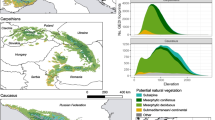Abstract
Purpose
The pressure of forestry operations on biodiversity is not appropriately characterized using existing life cycle inventories and impact assessment methodologies. As a consequence, it is not possible to distinguish between well-managed and poorly managed forests in terms of biodiversity. Several attempts have been made to establish a biodiversity impact assessment method to be used in life cycle assessment (LCA). Those methods cannot be easily implemented by practitioners, or they cannot be used to differentiate forestry practices. We therefore propose an alternative approach that requires limited data collection, while reflecting effects of forestry practices on biodiversity.
Methods
This paper demonstrates that the biodiversity level of managed boreal forests can be captured in LCA by means of a relatively simple method based on known forestry practices and using the notion of hemeroby, compatible with previously proposed approaches for biodiversity assessment. This method allows differentiating between wood products produced with different forestry practices from one and the same forest type.
Results and discussion
The proposed method is a clear improvement compared to commonly used approaches: it does not require measuring field data yet allows the quantification of potential environmental impacts of different forestry practices in boreal forests. The proposed inventory data and characterization factors can contribute to better assess the biodiversity impacts or benefits of forest management practices.
Conclusions
The present description demonstrates how a biodiversity evaluation can be conducted in the case of boreal forestry and how the way it is built converges to values that are comparable to field measurements. It also opens doors for similar methods to be developed for tree plantations under other climates and further to other types of land use.


Similar content being viewed by others
References
Brentrup F, Küsters J, Lammel J, Kuhlmann H (2002) Life cycle impact assessment of land use based on the hemeroby concept. Int J Life Cycle Assess 7:339–348
Bulle C, Jolliet O, Humbert S et al (2012) IMPACT World+: a new global regionalized life cycle impact assessment method. StartFragmentSociety of Environmental Toxicology and Chemistry 6th World Congress/Europe 22nd Annual Meeting, Berlin
Chaudhary A, Verones F, de Baan L, Hellweg S (2015) Quantifying land use impacts on biodiversity: combining species-area models and vulnerability indicators. Environ Sci Technol 49:9987–9995
Curran M, de Baan L, De Schryver AM et al (2011) Toward meaningful end points of biodiversity in life cycle assessment. Environ Sci Technol 45:70–79
de Baan L, Alkemade R, Koellner T (2012) Land use impacts on biodiversity in LCA: a global approach. Int J Life Cycle Assess 18:1216–1230
de Baan L, Curran M, Rondinini C et al (2015) High-resolution assessment of land use impacts on biodiversity in life cycle assessment using species habitat suitability models. Environ Sci Technol 49:2237–2244
de Souza DM, Flynn DFB, DeClerck F et al (2013) Land use impacts on biodiversity in LCA: proposal of characterization factors based on functional diversity. Int J Life Cycle Assess 18:1231–1242
Fehrenbach H, Grahl B, Giegrich J, Busch M (2015) Hemeroby as an impact category indicator for the integration of land use into life cycle (impact) assessment. Int J Life Cycle Assess 20:1511–1527
Forest Europe (2002) Improved Pan-European Indicators for Sustainable Forest Management. Ministerial Conference on the Protection of Forests in Europe (MCPFE), Vienna, Austria
Goedkoop M, Spriensma R (2001) The eco-indicator 99: a damage oriented method for life cycle impact assessment. Methodology Annex, Amersfoort
Jolliet O, Margni M, Charles R et al (2003) IMPACT 2002+: a new life cycle impact assessment methodology. Int J Life Cycle Assess 8:324–330
Koellner T, Scholz RW (2007) Assessment of land use impacts on the natural environment. Part 1: an analytical framework for pure land occupation and land use change. Int J Life Cycle Assess 12:16–23
Koellner T, de Baan L, Beck T et al (2013) UNEP-SETAC guideline on global land use impact assessment on biodiversity and ecosystem services in LCA. Int J Life Cycle Assess 18:1188–1202
Kowarik I (1999) Natürlichkeit, Naturnähe und Hemerobie als Bewertungskriterien. In: Konold W, Böcker R, Hampicke U (eds) Handb. Naturschutz und Landschaftspfl. Ecomed, Landsberg, pp 1–18
Lindner JP, Niblick B, Eberle U et al (2014) Proposal of a unified biodiversity impact assessment method. StartFragment9th International Conference LCA of Food, San Francisco, USA
Michelsen O (2008) Assessment of land use impact on biodiversity—proposal of a new methodology exemplified with forestry operations in Norway. Int J Life Cycle Assess 13:22–31
Michelsen O, McDevitt JE, Coelho CRV (2014) A comparison of three methods to assess land use impacts on biodiversity in a case study of forestry plantations in New Zealand. Int J Life Cycle Assess 19:1214–1225
Tiedemann A, Böttcher Tiedemann C, Buschardt A et al (2000) Ökobilanzen für graphische Papiere. Umweltbundesamt Deutschland, Berlin
Weidema BP (2008) Framework for and review of biodiversity indicators for forest management in the context of product life cycle assessment - Final report. 2.-0 LCA consultants, Hørsholm, Denmark
Weidema BP, Lindeijer E (2001) Physical impacts of land use in product life cycle assessment. Final report of the EURENVIRON-LCAGAPS sub-project on land use. Technical University of Denmark, Lyngby, Denmark
World Wildlife Fund (2015) WildFinder: Online database of species distributions. www.worldwildlife.org/wildfinder. Accessed 25 Nov 2015
Yamaguchi K, Ii R, Itsubo N (2016) Ecosystem damage assessment of land transformation using species loss. Int J Life Cycle Assess. doi:10.1007/s11367-016-1072-2
Acknowledgements
The authors would like to thank all the persons who provided information or feedback to help make this study possible, in particular Annukka Valkeapää (WWF Finland) and Horst Fehrenbach (IFEU Heidelberg).
Author information
Authors and Affiliations
Corresponding author
Additional information
Responsible editor: Hans-Jürgen Garvens
Electronic supplementary material
ESM 1
(PDF 996 kb)
Rights and permissions
About this article
Cite this article
Rossi, V., Lehesvirta, T., Schenker, U. et al. Capturing the potential biodiversity effects of forestry practices in life cycle assessment. Int J Life Cycle Assess 23, 1192–1200 (2018). https://doi.org/10.1007/s11367-017-1352-5
Received:
Accepted:
Published:
Issue Date:
DOI: https://doi.org/10.1007/s11367-017-1352-5




